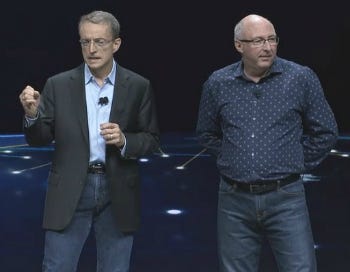VMworld 2018 Roundup: AWS Integration, SD-WAN, Endpoint Security Lead AgendaVMworld 2018 Roundup: AWS Integration, SD-WAN, Endpoint Security Lead Agenda
CEO Gelsinger and CTO O’Farrell laid out an ambitious, multicloud agenda, with a little help from Amazon's Jassy.
August 29, 2018


Kurt Marko
By Kurt Marko
During the opening keynote of its annual VMworld conference, VMware unleashed a barrage of announcements that showed a company moving far beyond its origins in server virtualization. Its goal: Become a horizontal provider of virtual infrastructure and management software for endpoints, edge devices and multiple cloud services.
After some self-congratulatory comments commemorating the 20th anniversary of VMware’s founding, CEO Pat Gelsinger and CTO Ray O’Farrell plunged into a packed keynote highlighting formal announcements that preceded the show. Judging by the order and length of Gelsinger’s treatment, VMware has positioned itself as an enterprise-focused, multicloud management company that spans the functional gamut, from core virtual infrastructure that can run in private data centers or public clouds to infrastructure, workload, security and cost management software.

VMware’s Pat Gelsinger and Ray O’Farrell on stage at VMworld 2018.
Indeed, VMware’s embrace of public cloud infrastructure and the SaaS delivery model over the past two years has been stunning.
Key announcements fell into six broad categories:
Public cloud integration, management and new service (VMware on AWS).
Edge infrastructure and remote networking (SD-WAN).
Application security (AppDefense, vSphere).
Multicloud virtual networking (NSX).
Container software (Kubernetes, PKS).
Client application delivery and endpoint management (Workspace One).
Much like last year, VMware’s partnership with AWS headlined the event, with AWS CEO Andy Jassy making a brief return appearance on stage to tout progress made via new features, an expanded global footprint and growing customer adoption over the past year. The most significant announcements for customers with feet in both VMware and AWS:
A significant price cut for VMware Cloud on AWS by reducing the minimum supported configuration from six hosts to three and offering a temporary three-node-for-the-price-of-two promotion.
Support for customizing the instance core counts to reduce costs for running software, like enterprise databases, licensed per CPU core.
An EBS-based, high-capacity storage option supporting volumes from 15 to 35 TB in 5 TB increments.
Support for NSX over Direct Connect links to allow network microsegmentation and security policies that span private and public clouds.
Better security with support for VSAN encryption that uses the AWS Key Management System (KMS)
Service expansion to AsiaPac via the AWS Sydney region.
In a surprising development, the AWS-VMware partnership has also led to …
… Amazon’s RDS relational database service being ported to VMware infrastructure, enabling the service to run either on-premises or in VMware’s AWS Cloud service.
Timing of the release was only vaguely specified as “the coming months,” but AWS re:Invent in late November is a logical guess. When available, RDS on VMware will support Microsoft SQL Server, Oracle, PostgreSQL, MySQL and MariaDB databases.
3 Areas To Watch
Network virtualization on fire: Gelsinger boasted of continued success for VMware’s NSX network virtualization product by noting sales metrics: It’s now in use by 7,500 customers, including 82 percent of the Fortune 100. Likewise, and no surprise to partners, SD-WAN is on fire, with Gelsinger saying that its recent acquisition, VeloCloud, “is the hottest product in VMware’s portfolio.” (Meet up with VeloCloud at Channel Partners Evolution.)
The NSX portfolio also received significant updates, including enhancements to NSX-T Data Center that allow expanding virtual network policies into various public clouds, including the aforementioned support for AWS. That joins previous support for Azure and PKS containers running on-premises or on Google Cloud. NSX also now supports bare-metal Linux hosts and, through a new partnership with Arista, can push security policies to physical switches.
Automating and securing VMware infrastructure: VMware’s core vSphere platform and vRealize management suite weren’t left out of the news parade. The company introduced a platinum version of vSphere that includes the AppDefense security product. AppDefense also gained tighter integration with NSX to enable automatic microsegmentation and firewalling based on application-level security policies. VSAN received minor updates with data-driven automation improvements that promise to reduce management overhead and a cluster creation wizard that simplifies configuration and deployment.
The vRealize management suite simplified automation by borrowing a technique from intent-based networking via the ability to automatically place workloads on systems and PKS clusters based on business policies. VMware also adds integrations for Ansible users to allow DevOps teams to use the popular orchestration engine as a front end for vRealize. Company CTO O’Farrell previewed several automation projects designed to further reduce IT operations workloads, with the aspirational goal of what VMware calls the “self-driving data center” that uses a massive collection of system telemetry and machine learning to optimize configurations and adapt to changing workloads and capacity demands.
Enabling the multicloud enterprise: Collectively, VMware’s announcements seek to make it the preferred provider of multicloud infrastructure and management software, including via VMware-management SaaS offerings. It’s a compelling strategy for partners and their clients, but is one firmly rooted in VMware’s enterprise server and storage products and should thus be of most interest to partners with existing VMware-based services and customers with a large base of VMware systems. And, as we’ve reported, enhancements to the VMware Cloud Provider Platform should help solution providers monetize the multicloud opportunity.
Kurt Marko is an independent analyst and a contributing editor for Channel Futures & Channel Partners.
Read more about:
AgentsYou May Also Like
